Sources
51°07′23″N4°40′59″E / 51.123°N 4.683°E / 51.123; 4.683
| Rameyen Castle | |
|---|---|
| Berlaar, Belgium | |
| Type | Castle |
| Site information | |
| Owner | NV Hof Van Rameyen |
| Open to the public | no |
Rameyen Castle (Dutch : Hof van Rameyen) is a castle on a lake in Gestel, part of the municipality of Berlaar, in the province of Antwerp, Belgium. It was once owned by Nicolaas Rubens, Lord of Rameyen, who died in the castle. Nicolaas was the second son of Peter Paul Rubens.
The first known owner of Rameyen castle in Gestel was Jan II Berthout van Berlaer who lived in the castle in 1303. The oldest part of the castle is the square keep. This heavy tower dates to the 13th century. The keep was fitted with cannon holes in the 16th century.
A beautiful castle was built around the keep by Van Immerseele and de Cock families. Boudewijn de Cock sold the castle in 1643 to Nicolaas Rubens, Lord of Rameyen, the second son of the famous painter Pieter Paul Rubens. The castle stayed as a property of the Rubens family until 1759. During the 17th century the castle underwent major restorations and remodelling but at the end of the same century the castle stood empty and decay started. The restoration took place in the 19th century when Esquire Nicolaas Joseph Alphonse de Cock came in possession of the castle. The Esquire lived in the castle until 1888. Other restorations took place in 1906. During WWI the castle was damaged but the restorations were already finished before the war ended. The last restorations took place in 1960.
Joseph and Claartje de Gruyter bought the 700-year-old castle in 1995. “It was love at first sight,” Mrs. de Gruyter recalled of the castle, situated near Antwerp in northern Belgium. But the moated chateau, while livable, desperately needed modernizing. So shortly after moving in, the couple sought help from Rutger Steenmeijer, of R. Steenmeijer & H. Baksteen architects, and Axel Vervoordt. For the first three years, the de Gruyters set up house in the main part of the castle to familiarize themselves with the space while the renovation team worked on the outlying buildings, which included private stables, a coach house and caretaker's cottage. They then moved into the coach house while Mr. Steenmeijer and Mr. Vervoordt turned to the main dwelling. The renovation took over 6 years with a budget over 12 M. Euro
In November 2015, Family de Gruyter sold the property to NV Hof Van Rameyen a Belgian investment company.
51°07′23″N4°40′59″E / 51.123°N 4.683°E

Beveren is a municipality in the Belgian province of East Flanders which comprises the towns of Beveren, Doel, Haasdonk, Kallo, Kieldrecht, Melsele, Verrebroek and Vrasene.
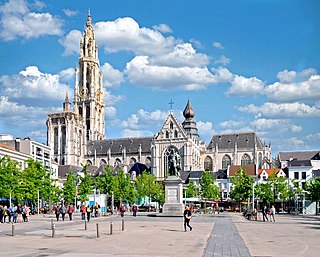
The Cathedral of Our Lady is a Roman Catholic cathedral in Antwerp, Belgium. Today's seat of the Diocese of Antwerp started in 1352 and, although the first stage of construction was ended in 1521, has never been 'completed'. It was constructed in the Gothic style by architects Jan and Pieter Appelmans. It contains a number of significant works by the Baroque painter Peter Paul Rubens, as well as paintings by artists such as Otto van Veen, Jacob de Backer and Marten de Vos. The cathedral is the largest Gothic church in Belgium, with its tower rising 123 meters over the city.

St. James' Church is a former collegiate church in Antwerp, Belgium. The church is built on the site of a hostel for pilgrims to Santiago de Compostela. The present building is the work of the Waghemakere family and Rombout Keldermans, in Brabantine Gothic style. The church contains the grave of Peter Paul Rubens in the eastern chapel.

The Royal Museum of Fine Arts Antwerp is a museum in Antwerp, Belgium, founded in 1810, that houses a collection of paintings, sculptures and drawings from the fourteenth to the twentieth centuries. This collection is representative of the artistic production and the taste of art enthusiasts in Antwerp, Belgium and the Northern and Southern Netherlands since the 15th century.

The Castle de Renesse is a castle located in the village of Oostmalle (Malle), in the Campine region of the province of Antwerp. It is currently owned by the municipality of Malle.

Gaasbeek Castle is a castle located in Lennik, Flemish Brabant, Belgium. Nowadays, it serves as a national museum. It is surrounded by a park.
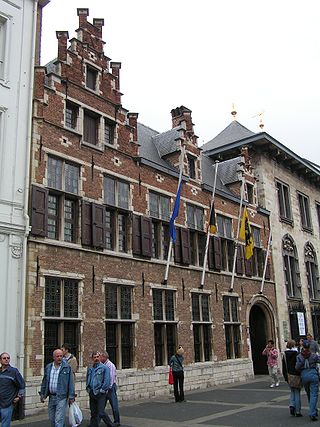
The Rubenshuis is the former home and workshop of Peter Paul Rubens (1577–1640) in Antwerp. Purchased in 1610, Rubens had the Flemish townhouse renovated and extended on the basis of designs by Rubens himself. After the renovations, the house and its courtyard garden had the outlook of an Italian palazzo, which reflected the artistic ideals of Rubens. The ensemble is now a museum dedicated mainly to the work of Rubens and his contemporaries.
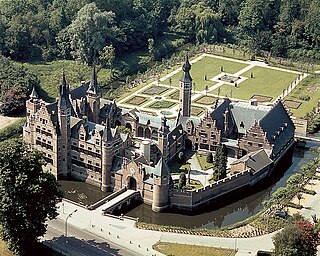
The Sterckshof castle is in Deurne, Antwerp, Belgium. From 1994 to 2014 it housed the Sterckshof silver museum of the Province of Antwerp. Built on the site of a much older castle, or great house, the present building is a reconstruction erected in the 1920s.

HelenaFourment was the second wife of Baroque painter Peter Paul Rubens. She sat for a few portraits by Rubens, and also modeled for figures in Rubens' religious and mythological paintings.

St. Paul's Church is a Roman Catholic church located at the Veemarkt in Antwerp, Belgium. Its exterior is mainly Gothic with a Baroque tower while the interior is characterised by its rich Baroque decoration. It holds paintings by Antwerp's leading artists Peter Paul Rubens, Anthony van Dyck and Jacob Jordaens as well as abundant sculpture and church furniture crafted by leading Antwerp sculptors such as Artus Quellinus the Elder, Pieter Verbrugghen I, Jan Pieter van Baurscheit de Elder, Jan Claudius de Cock and Andries Colyns de Nole. Of particular note is the Calvary outside the Church which is made up of 63 life-size statues and nine reliefs executed in a popular and theatrical style.

The Rockox Triptych or Epitaph of Nicolaas Rockox and His Wife Adriana Perez is a triptych painted by the Flemish painter Peter Paul Rubens between 1613 and 1615. It is in the collection of the Royal Museum of Fine Arts Antwerp.

St. Walburga Church or Burchtkerk was a Roman Catholic parish church in Antwerp, modern-day Belgium. It was demolished in 1817.
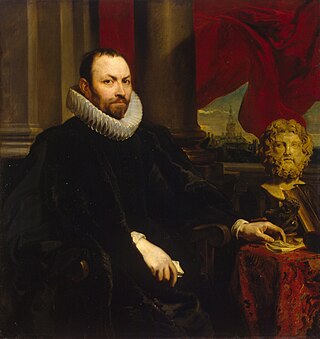
The Snijders&Rockox House is a museum in Antwerp, Belgium. It is located in two neighbouring townhouses formerly owned by the artist Frans Snyders (1579–1657) and the mayor Nicolaas Rockox (1560–1640). It is owned by KBC Bank and showcases a collection of 16th and 17th century Flemish art.

The Goubau family was an important noble family of Antwerp, many of its members are related to other important families.

Nicolaas Rockox (1560–1640), was an art patron and collector, numismatist, humanist, philanthropist and mayor of Antwerp. He was a close personal friend and important patron of Peter Paul Rubens. His residence in Antwerp was a centre where Antwerp's humanists and artists congregated and housed a large collection of artworks, antiques, rare objects and coins. It is now a museum known as the Snijders&Rockox House. He was knighted by Archduke Albert and Isabella, the Governor General of the Habsburg Netherlands.
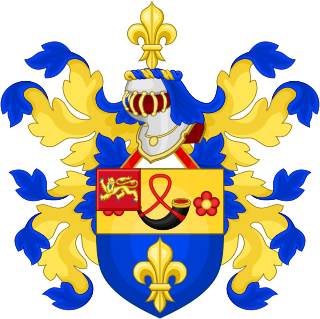
The Rubens family is a Flemish noble family that lived in Antwerp.

Nicolaas Peter Paul Rubens, Lord of Rameyen (1618–1655) was a son of the painter Peter Paul Rubens and Isabella Brant.
Nicolaas is the Dutch equivalent of the masculine given name Nicholas. Before the 19th century the name was also written Nicolaes, while Nikolaas is an uncommon variant spelling. Most people with the name use a short form in daily life, like Claas, Claes, Klaas, Nico, and Niek.
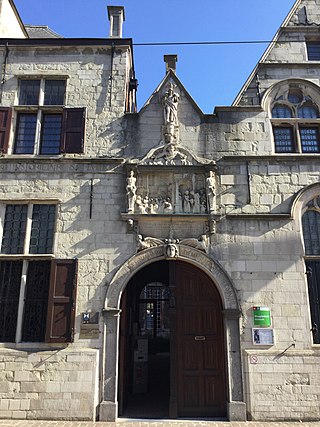
The Maagdenhuis Museum is an art museum and historical museum located in a 17th-century historic building on Lange Gasthuisstraat, Antwerp, Belgium. The building was used as an orphanage for the maegdeckens, or maidens, from the mid-16th century to the end of the 19th century. The museum presents a collection of utensils used daily by the foundlings and the orphans; a collection of antique furniture, and a series of documents relating to the orphanage and the life in it from the 16th century to 19th century.

Geldrop Castle is a castle with park near the center of Geldrop, North-Brabant, the Netherlands. It is on the edge of the valley of the Kleine Dommel.